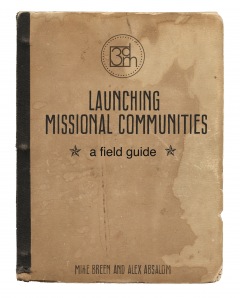 Guest Book Review by Jay Jacobs, a pastor in Austin City Life church
Guest Book Review by Jay Jacobs, a pastor in Austin City Life church
Launching Missional Communities is a very useful new resource by Mike Breen and Alex Absalom. (Mike and Alex come from St. Thomas Church in Sheffield England where they helped pioneer the UK movement of missional communities. They both lead in the United States now through the 3DM network.)
Overview
There are five sections to this book. Introduction, Key Concepts, Practical Launching Guide, MC Life and Case Studies.  What will set this resource apart long term will be sections 3-5 because of how detailed, practical and realistic the ideas, suggestions and examples are. I highly recommend these sections of the book for new MC leaders and pastors who are trying to model this but need some coaching and have lots of practical questions.
Sometimes the key isn’t the authors answers to the questions but seeing that they have wrestled and are wrestling with the same questions. There are calendar examples, discussions on how to deal with pastoral issues, kids, singles, the poor and even kids with bad behavior!  Many pastors will want to cover the first section of the book in great detail and then hit the index as necessary for the rest of the book .
The Size of Missional Communities
Here are some big take aways  I have from this first section of the book. First, the authors take a hard stance  on the size of MC’s and the need for 20-50 people. They recommend this mid-size group to meet 1-2x a month and then small groups to form out of these groups for more personal discipleship.    They reinforce the MC size with insights based on the 4 sociological categories of :
- public space – Over 100 People
- social space – missional community or cluster (20-50 people)
- personal space– small group (3-12 people)Â &
- intimate space – accountability partners (1-3 people)
My first reaction was that mc’s should be more about missional than the exact size or  structure but the authors make some great points here with these categories that shouldn’t be easily dismissed. They highlight that though it is easier to gather 8-12 people in a living room these groups are sometimes by default inward focused and personal in nature. When a group approaches 20 it is still “small enough to care but big enough to dareâ€, where a small group can dream big but may have a hard time carrying out missional initiatives in the long run.
A medium sized group can carry a heavier load in monthly missional activity and creates the kind of collective witness  by its size and energy that is difficult for a smaller group to display. I find this very thought provoking because of what we are feeling at our church with a need to cluster our missional communities (avg 10-20 adults) for more energy and more church wide missional alignment and focus. We were already having some discussion around these pain points and the feeling that some of our MCs were so focused on keeping the balance of gospel, community and mission that sometimes they are freed up to do any of them well. I think the advantage of a MC being larger could free up a more “personal†sized group to go naturally deeper into discipleship issues without the risk of losing a missional identity.
Identifying your Mission
I also gleaned a lot of insight from the authors emphasis on finding a “person of peace†based on Jesus teaching in Luke 10 where the disciples were to find and then stay in the home of a “man of peaceâ€. This metaphor is a powerful tool to teach people about incarnational and natural relational rhythms of mission. It seems like there is a gravitational pull in even the missional church to make mission about a program or a monthly project instead of about real people and deep relationshsips. This idea of looking for the “person of peace†within the relationships in our city groups is helpful.We should ask, “what people group is God putting on our heartâ€? and ask, “what person has got put in our network of friendships†that we should listen to, invest time in and go with them to get to know the world they live in outside of our church?  The authors stress that we should often “recognize mission†as opposed to “starting missionâ€.
Families & Children in Missional Communities
Many will enjoy the section on families and kids in MC’s and the authors emphasis on flexibility. They make the great observation that kids need to see their parents engaged in Christian community and mission in real settings and real relationships beyond Sundays. This is half of the benefit of MC’s for kids as theology and values are caught with kids more than taught.   They walk through all the different options of what to do with kids from hiring out childcare to involving them in the full discussion and gives some great hybrid examples and ideas of how parents can be more intention with discipling the kids, involving them but yet protecting some personal discussion time for the adults.
Conclusion
This is a great resource that I would recommend. The last section of the book with case studies deals with churches planting with a MC DNA and some transitioning to MC’s midstream. I didn’t find this section as helpful because it was sometimes confusing which church was transitioning and which were new church plants.
You may also want to read JR Rozko’s review of this book and Breen’s response that follows on the topic of missional vs. attractional church.
Disclosure of Material Connection: I received this book free from the publisher. I was not required to write a positive review. The opinions I have expressed are my own. I am disclosing this in accordance with the Federal Trade Commission’s 16 CFR, part 255: “Guides Concerning the Use of Endorsements and Testimonials in Advertising.â€
